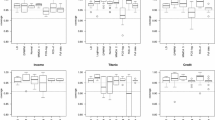Abstract
We propose a new method to impute missing values in mixed data sets. It is based on a principal component method, the factorial analysis for mixed data, which balances the influence of all the variables that are continuous and categorical in the construction of the principal components. Because the imputation uses the principal axes and components, the prediction of the missing values is based on the similarity between individuals and on the relationships between variables. The properties of the method are illustrated via simulations and the quality of the imputation is assessed using real data sets. The method is compared to a recent method (Stekhoven and Buhlmann Bioinformatics 28:113–118, 2011) based on random forest and shows better performance especially for the imputation of categorical variables and situations with highly linear relationships between continuous variables.









Similar content being viewed by others
References
Benzécri JP (1973) L’analyse des données. L’analyse des correspondances. Dunod, Tome II
Breiman L (2001) Random forests. Mach Learn 45(1):5–32
Bro R, Kjeldahl K, Smilde AK, Kiers HAL (2008) Cross-validation of component model: a critical look at current methods. Anal Bioanal Chem 390:1241–1251
Cornillon PA, Guyader A, Husson F, Jégou N, Josse J, Kloareg M, Matzner-Løber E, Rouvière L (2012) R for Statistics. Chapman and Hall/CRC, Boca Raton
de Leeuw J, Mair P (2009) Gifi methods for optimal scaling in R: The package homals. J Statist Software 31(4):1–20, URL http://www.jstatsoft.org/v31/i04/
Escofier B (1979) Traitement simultané de variables quantitatives et qualitatives en analyse factorielle. Les cahiers de l’analyse des données 4(2):137–146
Gifi A (1990) Nonlinear multivariate analysis. Wiley, Chichester
Greenacre M, Blasius J (2006) Multiple correspondence analysis and related methods. Chapman and Hall/CRC.
Husson F, Josse J (2012) missMDA: Handling missing values with/in multivariate data analysis (principal component methods). URL http://www.agrocampus-ouest.fr/math/husson, r package version 1.4
Ilin A, Raiko T (2010) Practical approaches to principal component analysis in the presence of missing values. J Mach Learn Res 99:1957–2000, URL http://dl.acm.org/citation.cfm?id=1859890.1859917
Josse J, Husson F (2011) Selecting the number of components in PCA using cross-validation approximations. Comput Statist Data Anal 56(6):1869–1879
Josse J, Husson F (2012) Handling missing values in exploratory multivariate data analysis methods. Journal de la Société Française de Statistique 153(2):1–21
Josse J, Pagès J, Husson F (2009) Gestion des données manquantes en analyse en composantes principales. Journal de la Société Française de Statistique 150:28–51
Josse J, Chavent M, Liquet B, Husson F (2012) Handling missing values with regularized iterative multiple correspondence analysis. J Classif 29:91–116
Kiers HAL (1991) Simple structure in component analysis techniques for mixtures of qualitative and quantitative variables. Psychometrika 56:197–212
Kiers HAL (1997) Weighted least squares fitting using ordinary least squares algorithms. Psychometrika 62:251–266
Lafaye de Micheaux P, Drouilhet R, Liquet B (2011) Le logiciel R. Springer, Paris
Lang DT, Swayne D, Wickham H, Lawrence M (2012) rggobi: Interface between R and GGobi. URL http://CRAN.R-project.org/package=rggobi, r package version 2.1.19
Lebart L, Morineau A, Werwick KM (1984) Multivariate descriptive statistical analysis. Wiley, New York
Little RJA, Rubin DB (1987, 2002) Statistical analysis with missing data. Wiley series in probability and statistics, New York
Mazumder R, Hastie T, Tibshirani R (2010) Spectral regularization algorithms for learning large incomplete matrices. J Mach Learn Res 11:2287–2322
Michailidis G, de Leeuw J (1998) The Gifi system of descriptive multivariate analysis. Statist Sci 13(4):307–336
Peters A, Hothorn T (2012) ipred: Improved Predictors. URL http://CRAN.R-project.org/package=ipred, R package version 0.9-1
R Development Core Team (2011) R: A Language and Environment for Statistical Computing. R Foundation for Statistical Computing, Vienna, Austria, URL http://www.R-project.org/, ISBN 3-900051-07-0
Rubin DB (1976) Inference and missing data. Biometrika 63:581–592
Schafer JL (1997) Analysis of incomplete multivariate data. Chapman and Hall/CRC, London
Stekhoven D, Bühlmann P (2011) Missforest - nonparametric missing value imputation for mixed-type data. Bioinformatics 28:113–118
Tenenhaus M, Young FW (1985) An analysis and synthesis of multiple correspondence analysis, optimal scaling, dual scaling, homogeneity analysis and other methods for quantifying categorical multivariate data. Psychometrika 50:91–119
Troyanskaya O, Cantor M, Sherlock G, Brown P, Hastie T, Tibshirani R, Botstein D, Altman RB (2001) Missing value estimation methods for DNA microarrays. Bioinformatics 17(62001):520–525
van Buuren S (2007) Multiple imputation of discrete and continuous data by fully conditional specification. Statist Method Med Res 16:219–242
van Buuren S, Boshuizen H, Knook D (1999) Multiple imputation of missing blood pressure covariates in survival analysis. Statist Med 18:681–694
van der Heijden P, Escofier B (2003) Multiple correspondence analysis with missing data. In: Analyse des correspondances, Presse universitaire de Rennes, pp 153–170
Vermunt JK, van Ginkel JR, van der Ark LA, Sijtsma K (2008) Multiple imputation of incomplete categorical data using latent class analysis. Sociol Methodol 33:369–397
Author information
Authors and Affiliations
Corresponding author
Rights and permissions
About this article
Cite this article
Audigier, V., Husson, F. & Josse, J. A principal component method to impute missing values for mixed data. Adv Data Anal Classif 10, 5–26 (2016). https://doi.org/10.1007/s11634-014-0195-1
Received:
Revised:
Accepted:
Published:
Issue Date:
DOI: https://doi.org/10.1007/s11634-014-0195-1




